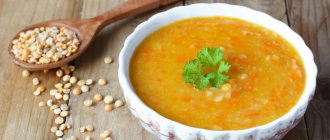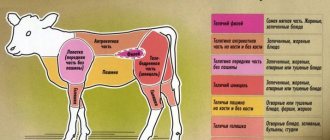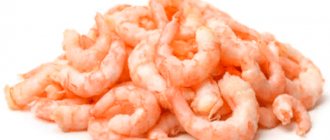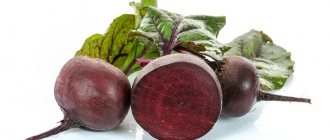Breast milk is the ideal food for a baby from birth. But by the time the baby reaches six months of age, the nutrients in mother’s milk become insufficient for normal development. The baby needs solid food, so mothers have a question: at how many months should we introduce complementary foods and what product should we start with? Zucchini (recipes for zucchini puree for an infant) and mashed potatoes for an infant are the first courses in the diet.
From what month can a baby be given mashed potatoes?
Most children like potato dishes, so mothers who have started introducing complementary foods are always interested in finding out when you can prepare mashed potatoes for your baby and how to give it to your baby correctly.
Potatoes have a positive effect on the digestive and cardiovascular systems. This vegetable contains a lot of potassium, iron, iodine, phosphorus and other elements, as well as organic acids, antioxidants and vitamins.
Most of the nutrients are preserved not in boiled, but in baked potatoes, so it is recommended to bake the vegetable for baby purees.
Another advantage of potato dishes is their pleasant taste, which children like.
See the program “Live Healthy” about the benefits of potatoes for children and adults. You will also learn that it is worth eating raw potatoes, which, unfortunately, is not accepted in our country.
- Potato tubers are rich in starch, which can cause allergies and digestive problems.
- Boiled potatoes have a very high glycemic index.
- If the mother did not pay attention to the green spots on the root vegetables, then there is a risk of solanine poisoning the baby.
Selection of vegetables for puree and pre-processing
All parents want only the best for their baby, and this also applies to food. There are several rules for choosing potatoes for baby feeding.
- The root crop must be of domestic production. Ideally, you (or your relatives) grow it in your garden.
- It is better to buy potatoes in season, this reduces the likelihood of buying GMO products, as well as vegetables treated with chemicals.
- Give preference to medium-sized potatoes - they have more useful properties than small and large tubers.
- Do not make mashed potatoes for babies from greenish potatoes.
- You should not feed your baby potatoes with wrinkled skins, a whitish coating, or rotten barrels. The tuber should be smooth, hard, with an even skin.
- Pierce the potato. If juice starts to come out from the puncture site, it is better not to give such potatoes to the baby, as they contain a lot of nitrates.
Having chosen a natural, high-quality root vegetable, you can begin preparing complementary foods. At first glance, there is nothing complicated about this - boil the potatoes, mash them and give them to the child. But it's not that simple. Potatoes must first be freed from starch and nitrates.
- Remove the peel with a knife. Don't try to remove it in a thin layer. The more you cut, the better.
- Fill the tuber with water and leave for a day. This is necessary to remove excess starch and nitrates.
- Before cooking, cut the root vegetable into cubes.
Helpful: Is it healthy to feed a baby semolina?
How to choose?
For baby mashed potatoes, you should use small-sized tubers that do not have spots or defects. It’s best if mom can cook dishes from potatoes grown in her garden. If mom is not sure of the quality of market or store potatoes, she can purchase jarred food. In this case, a one-component product is preferable, to which salt and cream are not added. The puree that the mother decided to introduce the baby to should only contain potatoes and water.
Recipe for cooking at home
Potatoes can be baked, boiled in a double boiler or in boiling water under a lid. Baked or boiled potatoes need to be crushed until pureed, then add a little milk to the dish.
If this is the first time you try potatoes, then you should add breast milk, the broth in which the vegetable was cooked, or baby formula to the puree.
A little later, the chopped potatoes can be combined with cow's milk. Oil (preferably vegetable) should also be added to the potato dish.
Options for preparing puree
- Standard recipe (for children 5-6 months). You can buy baby puree in a jar, but it’s better to make it yourself. Peel the potatoes, cut into small cubes and cook in a saucepan. It is better to put potatoes in boiling water; there is no need to salt it, since excess salt is harmful to both children and adults. Since some of the beneficial substances remain in the water, there is no need to completely drain it and replace it with clean water. Mash the potatoes and add a little breast milk. You can use a blender or mixer, because the puree should be airy, without lumps. If the dish turns out to be rare, you need to pound it again, so it will become elastic.
- In a steamer. This method will help preserve more vitamins under the potato skin, and it is the most gentle. Cut the tuber into several parts and place in the device for 30 minutes. If the potatoes are young and small, place them whole in the bowl. Peel and further grind through a sieve, as it is difficult to get rid of lumps.
After the child has tried other vegetables and meat, you can prepare mixed purees from several components.
- Recipe for puree with zucchini (for children 7 - 8 months). Take vegetables in equal proportions, peel, remove seeds from zucchini, cut into cubes. Boil the vegetables, grind using a sieve or blender, add a little vegetable oil.
- Broccoli dish. Rinse the fruits with water, disassemble the cabbage into inflorescences. Cook the vegetables separately, blend in a blender with the addition of vegetable broth.
- Vegetable puree with carrots. After cutting the root vegetables into cubes, place them in a saucepan. Pour boiling water over and boil. Grind in a blender, add butter, salt, milk if desired. Boil the resulting puree.
- Option with meat (for children 8-9 months). To prepare this dish, you need to take 2 potatoes, minced meat (rabbit, turkey) and parsley. It is better to use minced meat not from the store, but to prepare it yourself. Boil the potatoes and meatballs, crush all the ingredients. If the child willingly eats solid food, the meat balls do not need to be crushed. Add a little salt and butter. Instead of minced meat, puree can be made with chicken liver.
Information
Both children and parents like potato dishes. It is not surprising that many kids begin to use it at a very early age . Potatoes are available, easy to buy or grow on your own plot. But it is important for a young mother to know from how many months this complementary food can be given to her baby. It is also important to cook potatoes correctly, choosing only fresh young fruits. Otherwise, an allergy may occur.
Related article: How to choose potatoes for planting - tips for buying tubers
Positive properties of potatoes. Why is this product recommended for young children?
- Effect on the digestive as well as nervous system. The root vegetable is rich in iodine, potassium, iron, and phosphorus. Potatoes contain vitamins and minerals that are beneficial and necessary for a growing body. To preserve them, you need to properly prepare the product.
- Pleasant taste. Potatoes are never too salty or sweet. The taste of mashed potatoes is unobtrusive and light, which is what children like so much. This complementary food is suitable for an infant: it does not cause irritation. It is better to prepare mashed potatoes, but baked potatoes will also work.
There are also disadvantages. They can be avoided if you choose good fruits and monitor the child’s reaction.
- Allergies may occur because the tubers are rich in starch. Therefore, you need to monitor the reaction of children: this is especially true for the first feeding. Giving and preparing mashed potatoes for babies should be done carefully. If the baby becomes ill, nausea, vomiting, weakness appear, complementary feeding should be stopped and consult a doctor. Allergies in infants are more severe and the help of a doctor is always required.
- Only light young fruits without spots are suitable for complementary feeding. Green spots are dangerous: they can poison the baby with solanine. Mom should carefully choose potatoes to prepare complementary foods. Tubers grown on your own plot are useful, but they also need to be inspected: they can be damaged by worms.
At what age (in months) can a baby be given mashed potatoes? How old should the baby be? What is the best way to do this and how to prepare puree? At what age can you safely introduce it into your diet? These questions concern inexperienced mothers. There is a general opinion, but it is better to consult a doctor, since all cases are individual.
For babies who received only breast milk, potatoes are introduced into complementary foods from 6 months. If the baby is artificially fed, the first complementary feeding can be started at 5 months, but it is better not to rush and wait until six months.
Along with this product, other vegetables can be introduced into complementary foods: zucchini, cabbage. But this must be done carefully: allergies in 6-month-old babies occur due to the wrong combination of foods. It is better to consult a pediatrician about everything. You should also carefully monitor the child’s reaction: his condition, mood, stool.
Some doctors say that potatoes should be introduced into complementary foods after fermented milk products and cereals. The baby's digestive system will get used to pureed foods, so it will be easier to digest the vegetable. You can first prepare the decoction, and only then move on to the puree. In this way, eating disorders will be avoided and allergies will not occur.
Potatoes are a healthy product
Per 100 grams of this vegetable, peeled, there are 76 grams of water, 16.3 grams of carbohydrates, 2 grams of protein, 0.4 grams of fat, 1.1 grams of ash, 1 gram of fiber, 0.7 grams of pectin, 0.2 grams of organic acids.
Let's figure out what beneficial qualities potatoes have:
- High content of vitamins: ascorbic acid - 15 mg, choline - 13 mg, niacin 1.3 mg, thiamine 0.09 mg, and others in smaller quantities (vitamins B5, A, B2, E, B6, K, folic acid).
- The presence of a wide variety of micro- and macroelements. K (460 mg), P (56 mg), Na (28 mg), Mg (20 mg), Ca (10 mg) predominate, in smaller quantities: Fe, I, Co, Mn, Cu, Mo, Se, F , Zn.
- Potatoes have a beneficial effect on the cardiovascular and nervous system.
- Normalization of metabolism and water-salt balance in the body.
- Regulation of acid-base balance.
- It is used as a medicine to treat colds, headaches, kidney pathologies, gastrointestinal diseases, and burn conditions.
- It is a source of energy for a growing organism and covers a tenth of its needs.
Along with the beneficial qualities, it is worth noting the risk of identifying a baby’s allergy to starch. Also, if there is an excess of potatoes in a child’s diet, you risk causing constipation and obesity. You should not eat fruits that have sprouted or turned green. Such vegetables contain a high content of corned beef, which is poisonous to the body of children.
You need to know that potatoes are strictly prohibited for people who have been diagnosed with flatulence, colic, diabetes, urolithiasis, gastritis with high acidity, or obesity.
How to introduce it into your diet
How many months should a baby be? A new dish should be given to a baby from 6 months old carefully and gradually. You can just give it a sniff at first, and then treat it with a teaspoon of puree. If the baby reacted normally, next time you can increase the portion. The child should have good stool and there should be no discomfort. Therefore, after the first feeding you need to wait for some time.
If the mother notices bad signs in the child’s mood or condition, complementary feeding should be postponed. Perhaps mom just couldn't cook the potatoes properly. When your baby develops an allergy, you should postpone such feeding or even consult a doctor.
You definitely shouldn’t give puree before 5 months. At this age, the baby’s body is not yet accustomed to such food. Experienced mothers advise mixing breast milk with mashed potatoes first. This will make it easier to digest.
How to choose
If an adult can eat any tubers, then with baby food everything is different. A baby at 6 months should be given food prepared from new potatoes as complementary foods. Vegetables should be small and juicy. There should be no damage, stains or plaque. It is strictly forbidden to use and prepare puree from tubers damaged by insects.
Tubers from your own garden are most suitable. You need to be careful when buying store-bought ones: they often contain chemicals for growth and storage. Potatoes grown in your own garden are more beneficial, especially for a child.
There is also canned food. When mom cannot determine the quality of a purchased product, you can buy a canned one. For very small children, you can prepare one-component puree that does not contain salt, cream, sugar, or additives.
When a mother decides to prepare puree herself and give it to her baby, she should not add anything other than water to the dish. Potatoes and plain water are the best ingredients for baby food. This can be the first complementary food. The recipe according to which the potato tubers were prepared also matters. They just need to be baked or boiled.
Article on the topic: Potato planting rate per 1 hectare and hundred square meters (in pcs. and kg)
What recipe should I use to make the most delicious and healthy puree? There are only two of them: bake and boil. Already prepared vegetables are crushed to the smallest state. Then add a little milk, preferably breast milk. This recipe is great for babies: tasty and satisfying.
There is a recipe for those who are bottle-fed: with the addition of baby formula. There is also a recipe with vegetable oil and cow's milk. But it is not suitable for the first feeding: it is better to give it to slightly older children. And for the first time it is better to use a recipe with breast milk.
You need to chop the potatoes as finely as possible. The mixture should not be very liquid, but there should not be any solid pieces. It is better to dilute the puree with mother’s milk, and gradually transfer the child to cow’s milk, otherwise an allergy will occur.
- Many mothers strive to preserve vitamins and often do not even finish cooking the potatoes. It is undesirable to give such a dish to a 6-month-old child as complementary food: not only can an allergy occur, but also poisoning can occur. It is necessary to soak the tubers in cold water before cooking. Some vitamins will be lost, but starch will not do any harm. How long to cook? Better longer.
- The first feeding of mashed potatoes occurs without salt and sugar. There should only be water and potatoes. The recipe with a salted dish is suitable for older children.
- There is no need to abuse such dishes. Potatoes are healthy and have a pleasant taste, but they contain starch: this substance can be harmful. You can give puree to your baby 2-3 times a week, but not more often. Otherwise, an allergy will occur.
- You need to prepare and give food to your baby right away. Even if it sits in the refrigerator, the beneficial properties are lost and the taste changes. They give the baby only fresh food that the mother has just prepared.
- It is better to grind the potatoes yourself, rather than in a blender. The latter forms gluten.
- It is recommended to boil potatoes in their skins, rather than peeled. Then the skin is removed and the tubers are crushed. You can also steam it.
Potato and cauliflower puree
Vegetables are washed and peeled well. You can take them in any proportions. If the child does not like potatoes, you can take just a little, increasing the amount each time.
The products are placed in a pan and filled with water. You can add dill. Boil everything until tender, then chop it. To do this, use a blender, masher or sieve. The puree is made from vegetable broth; milk can be added if desired. Olive oil is added to the finished dish if desired - 1 teaspoon per serving is enough for babies.
Potatoes in complementary feeding for infants: when and how to introduce them?
Potatoes are a very popular product on our table. It is impossible to imagine our daily diet without it. In addition, it is healthy: rich in potassium, magnesium, selenium, B vitamins, and carbohydrates.
Therefore, the child must become acquainted with it. When should potatoes appear in baby's complementary foods? How to introduce and prepare it? Let's figure it out.
Age and dosage
So, question one: at what age can a child have potatoes? In general, it is better to introduce any complementary foods no earlier than six months.
But potatoes are a rather heavy product for a small body. It contains a lot of starch, which can reduce intestinal motility and cause increased gas formation and constipation.
In addition, it is quite high in calories, and this is an additional burden on digestion and kidneys. Therefore, it is definitely not suitable as a first complementary food.
Give preference to lighter vegetables: broccoli, zucchini, cauliflower (see article: How to cook zucchini for the first feeding?>>>).
So when can you introduce potatoes into baby food? Not earlier than 7 months (and possibly later).
Important! At the same time, remember that at least 3 days must pass after the introduction of the previous product, provided that there was no allergic reaction to it.
But how many potatoes you can give your child depends on what type of complementary foods you choose.
- If it is pediatric, the goal of which is to gradually transfer the baby to food from the adult table, then in a month the potato norm can be increased to 150 g (no more than three times a week). By the year the portion can “grow” to approximately 180 - 190 g;
- If you prefer pedagogical complementary feeding, then the goal here is simply to introduce the baby to new food when he begins to show interest in the dishes of his parents on their plates.
Accordingly, there is no need to completely replace meals with it. It will be enough to increase the portion to 50 g. At the same time, the child eats from his mother’s dishes, trying what she eats, which means he feels involved in adult affairs.
For more information about these types of complementary feeding + about many educational points on the child’s behavior at the table, see the online course ABC of complementary feeding: a system for the safe introduction of complementary feeding to infants>>>
At what age is complementary feeding recommended?
When can infants be offered potato dishes as complementary foods? Without any risk to health - after porridge and fruits have become permanent components of their diet. Before introducing the starchy vegetable, cauliflower, zucchini, broccoli and onions are introduced into the kids' menu. Moreover, it is worth remembering that bottle-fed babies can try the innovation a month and a half earlier than breastfed babies.
When is the best time to feed potatoes? The optimal time is from one to three o'clock in the afternoon. At first, babies are offered literally half a teaspoon of mashed potatoes per day; by the age of one year, this portion gradually increases to 130-150 g.
The older the baby gets, the greater the range of potato dishes for complementary feeding that he is offered.
- Initially, children are offered purees or soups without spices and salt.
- After a year, babies can prepare potato dumplings, steamed pancakes and potato pancakes.
- At the age of 3 years, children can already eat fried foods, including potatoes, although in limited quantities.
Introduce potatoes according to the rules
Potatoes are a product with a moderate degree of allergenicity; reactions to its consumption in children occur quite rarely. But, nevertheless, do not neglect the general rules for introducing complementary foods.
So, how to introduce potatoes into your baby’s complementary foods correctly?
- Maintain an interval between introducing new products;
Related article: Planting potatoes with eyes, caring for seedlings and bushes
For ordinary children it is 3 days, for children prone to allergies - up to a week. That is, potatoes are introduced 3 to 7 days after the previous type of complementary feeding.
However, if you stay stuck on one product for too long, your baby may simply get bored with it. Please take this into account.
- Give potatoes before 14:00 so that you have time to monitor a possible reaction and take measures, for example, to reduce the amount of gases, then by night they will not torment your child;
- For the first time, do not mix potatoes with other products, even if the baby has already tried them separately and tolerated them without allergies: let them taste the pure taste;
- If your baby shows signs of an allergy after eating potatoes, temporarily remove potatoes from the child’s diet and reconsider your tactics for introducing complementary foods.
Important! I remind you once again that you should not give potatoes every day, spare your baby’s digestion!
The second question that probably worries you as a mother is: in what form can you offer your baby potatoes for the first feeding? The first rule, as already mentioned, is to introduce it in its pure form, as a monoproduct, or in the form of a regular puree. Other things to remember:
- Potatoes for children under one year old should not be seasoned with salt, pepper, onion, garlic, spices, or milk (read the article Milk in a child’s diet>>>);
- Before cooking, potatoes should be thoroughly washed and kept in water for 10 - 12 hours to reduce allergenicity, the amount of starch and nitrates. We change the water every 2 – 3 hours;
- Choose the right root vegetable. It must be young, without traces of rot, mold, black spots, without spots;
- Fruits that are too “watery” contain nitrates and should not be given either. Too old, green on one side, contain a toxic substance (corned beef), so you shouldn’t choose them either;
- By the way, if the potatoes are grown independently, without the use of chemicals, they do not need to be soaked before cooking.
- Don't cook too large a portion. It is better to give your child a fresh dish each time.
All about the benefits of potatoes
The digestive system of a baby in the first months of life is imperfect. She is able to absorb only breast milk or special milk formulas. Only by 9-9.5 months do enzymes appear in the child’s body that are capable of efficiently digesting starchy vegetables.
Why shouldn't you give up potatoes on your children's menu? Firstly, because young children are often prone to allergies, and the popular root vegetable causes it in extremely rare cases. If a reaction occurs, the starch contained in it is to blame. In addition to nutritional value and excellent taste, the vegetable has the following advantages:
- It is on sale all year round, its price is affordable for everyone.
- The feeling of fullness it gives is undeniable.
- It can be consumed at any stage of maturity; both young and old root vegetables are suitable for food.
- The body needs minerals every day, a fifth of which it gets from potatoes.
- Contains rutin, which protects against infections, strengthens blood vessels and capillaries.
- The composition includes selenium, which stabilizes the functioning of the thyroid gland.
- It is considered a powerful source of energy and a supplier of natural protein, which is needed for the construction and regeneration of cells.
- Contains minerals and plant fiber, regulates the digestive system, helps remove waste and toxins.
Potato starch lowers cholesterol levels, and folic acid in its composition stimulates brain development and is involved in the formation of the nervous system of a newborn.










